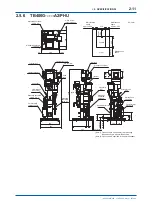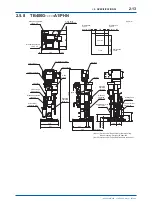
<1. OVERVIEW>
1-3
IM 12E04A02-02E
1.1.4 TB400G-
□
-
□
-A3 (with automatic cleaning and zero
calibration)
This is a system which comprises the TB400G-
□
-
□
-A1 model with the automatic cleaning and
automatic zero calibration functions added (see subsection 2.6.3).
The sampling system of this system incorporates solenoid valves at the cleaning water tubing
and zero calibration tubing and electric motor-operated valves under the header tank and at the
measuring-water tubing. These provisions automatically clean the measuring cell in the detector
and perform zero calibration in a sequence preset in the converter.
1.2 Operating
Principle
The operating principle of the scattered-light turbidimeter employs a method of measuring the
amount of the light scattering that takes place close to the surface of the water sample. The
measuring system comprises a detector and a converter. This section describes the meter
con
fi
guration and operating principle.
The detector is comprises a measuring cell and a detecting section. Sample that
fl
ows into the
measuring cell from the bottom of the cell over
fl
ows at the top of the cell.
Meanwhile, a tungsten lamp closed inside the detector emits light onto the surface of the sample
through a system of lenses. This light is separated into scattered, re
fl
ected, and transmitted
light on the water’s surface. The transmitted light and re
fl
ected light are absorbed in a dark area
equivalent to a black body.
This scattered-light intensity (L) is proportional to the turbidity as shown here:
L = K • Q • S
Where K: a constant relative to turbidity,
S:
turbidity,
Q: amount of light from the lamp.
The scattered light is detected by a turbidity element (a silicon photodiode). It is focused onto
the element with a lens inside the detecting section. This gives the scattered light signal to the
converter.
In addition, a reference element is incorporated in the detecting section to hold the amount a light
(Q) from the lamp constant, and it also provides a light-detection signal to the converter.
The measuring circuit of the converter is sealed in a housing of aluminum alloy together with the
operating panel and a terminal block for external wiring. This measuring circuit ampli
fi
es and
calculates the input from the turbidity element in the detector and outputs a signal (1 to 5 V DC or
4 to 20 mA DC) corresponding to the measuring range.
The converter also calculates the reference element input from the detector to control the lamp
voltage so that the amount of light from the lamp is constant.
3rd Edition : May. 31, 2010-00
Summary of Contents for Vigilant Plant EXA TB Series
Page 49: ...Blank Page ...
Page 59: ...Blank Page ...
Page 119: ...Blank Page ...
Page 125: ...Blank Page ...
Page 127: ...Blank Page ...
Page 133: ...Blank Page ...











































